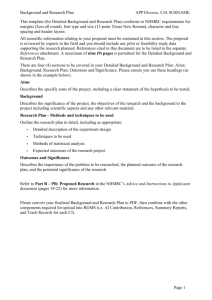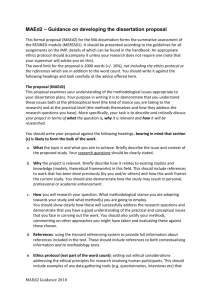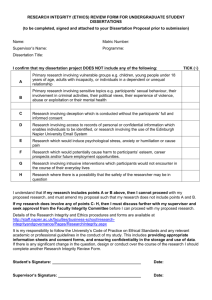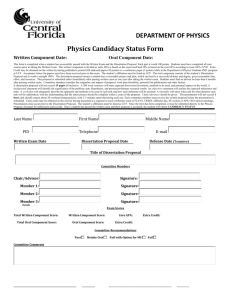POSTGRADUATE STUDY PLAN Doctor of Medicine Doctor of
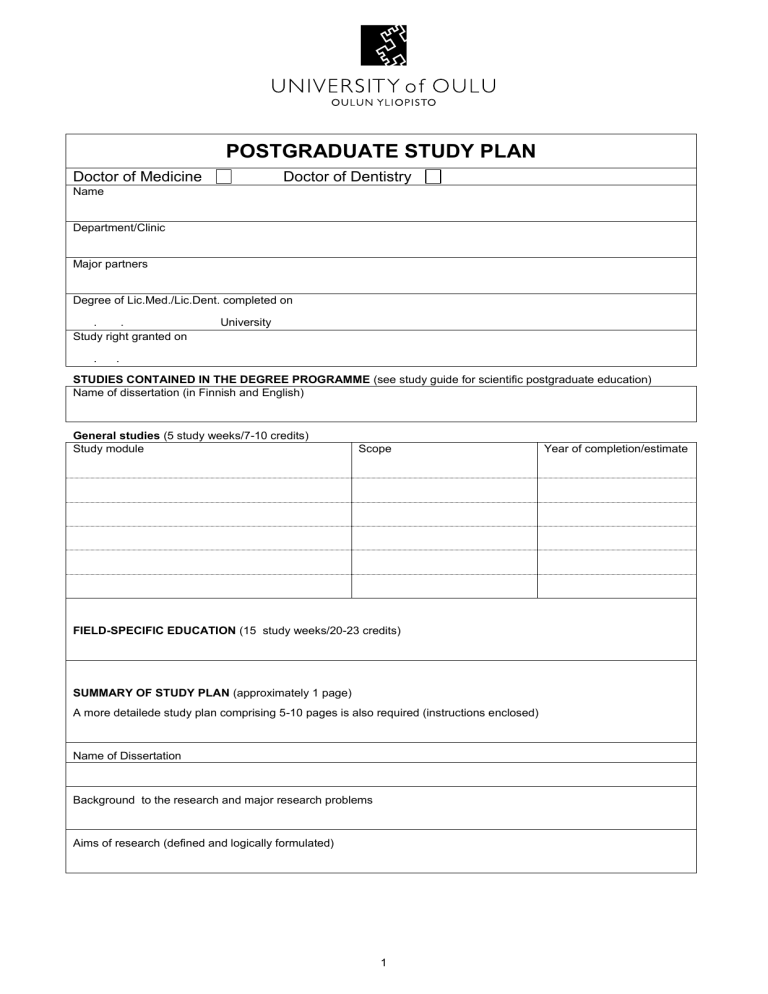
Doctor of Medicine
Name
Department/Clinic
POSTGRADUATE STUDY PLAN
Doctor of Dentistry
Major partners
Degree of Lic.Med./Lic.Dent. completed on
. . University
Study right granted on
. .
STUDIES CONTAINED IN THE DEGREE PROGRAMME (see study guide for scientific postgraduate education)
Name of dissertation (in Finnish and English)
General studies (5 study weeks/7-10 credits)
Study module Scope Year of completion/estimate
FIELD-SPECIFIC EDUCATION (15 study weeks/20-23 credits)
SUMMARY OF STUDY PLAN (approximately 1 page)
A more detailede study plan comprising 5-10 pages is also required (instructions enclosed)
Name of Dissertation
Background to the research and major research problems
Aims of research (defined and logically formulated)
1
Material and methods (general description of the methods to be used, test arrangements, test animals, patient material and statistics)
Form of publication
Monography Sub-investigation
Research timetable (present state of research, further investigations, estimated completion)
Ethical questions
Composition of the follow-up group
Name position title
Approval by supervisors and their signatures
Date Signature
. . 20 name in block letters, position and title
Date Signature
. . 20
Date name in block letters, position and title
Signature
. . 20 name in block letters, position and title
2
Approval of the subject’s main representative (Chief of the clinic ordepartment)
Date Signature
. . 20 name in block letters
Candidate´s signature
Date
. . 20
Signature
Address
3
ENCLOSURE
INSTRUCTIONS FOR COMPILING A RESEARCH PLAN
(see also the study guide for postgraduate education and the instructions of the
Academy of Finland in the address www.aka.fi )
Every person attending postgraduate education shall compile a postgraduate study plan that contains a research plan and plan covering theoretical studies. The research plan must be drawn up as early as possible, preferably immediately when the rough form of the dissertation is available. If the topic of the dissertation changes considerably, a new plan must be compiled. The plan must be drawn up under the supervisor’s control and must be approved by the supervisor. A follow-up group is presented in connection with the postgraduate study plan, which usually comprises 2-3 persons familiar with the field of the research (not supervisors). The plan is approved by the postgraduate education committee appointed by the Faculty of Medicine.
The research plan must be logically compiled and also comprehensible to evaluators not very familiar with the field of research. The plan can be written in
Finnish, Swedish or English.
I Guidelines for a research plan
Abstract ( maximum 1 page, provided with sub-headings )
- background, aims, implementation, present state of research, significance of results, form of dissertation (monography vs. sub-investigation) and timetable
1. Background to the research (very brief, maximum 1 page!)
- significance of research problem
- earlier investigations and their contributions
2. Setting of aims and questions (realistic, comprehensible, sufficiently concrete and well-defined)
- main problem and hypotheses
- secondary questions (not too many!)
- increase in knowledge as compared with earlier research
3. Study population
- criteria employed in the definition, inclusion and exclusion of individual observation units (e.g. healthy persons, patients with a given disease, animals)
- source of the population (e.g. total population of Oulu, patients in department
X), time and place (i.e. setting)
- selection of observation units and criteria for this (e.g. sampling, patient selection)
- number of observation units and criteria for this, calculation of sample size
- possible deviations in the selection and comparison of the population and how these can be anticipated
4
4. Research design
- research type: experimental research (e.g. randomised clinical test), nonexperimental comparative research (e.g. epidemiological risk factors, comparison of diagnostic methods), descriptive survey (e.g. community diagnosis, description of a series of cases) etc,
- accurate description of the research design (e.g. parallel group test or alternative test, single/multi-factor test, cohort or case-reference investigation),
- accurate definition of treatment or intervention to be used in experimental research (e.g. dosage, timing),
- time dimension in non-experimental research: cross-sectional or longitudinal design; in the latter case also the duration of the follow-up period,
- timing of observations in non-experimental research:: concurrent,
’prospective’, i.e. all observations and measurements performed in the course of the research, or historical, ‘retrospective’, i.e. observations based on material collected before the initiation of the research project,
- evaluation and comparison of diagnostic methods: standard criteria and methods to be studied,
- matching criteria employed when creating reference groups,
- other details connected with research design (e.g. randomising, camouflaging i.e. ‘blindfolding’).
5. Parameters and measurements
- basic target and response parameters
- principal explanatory and predictive factors
- description of measurement methods
- number of measurements of each parameter and their timing
- evaluation of the reliability (validity, consistency, repeatability) of the measurements and the effect of erratic values on the results
- provision for missing information and non-response
6. Processing and analysis of material
- organisation of data management (collection, storage and computer processing)
- statistical methods and their selection
- presentation of the results which answer the main questions examined
(tables or figures, selection of parameters, evaluation of random error)
7. Ethical questions
- ethical evaluation of the research – own consideration (not enough to state that a permission has been applied and obtained from the Ethical
Committee!)
- possible hazards and risks entailed to animals and subjects and precautions taken to anticipate these
5
- obtaining of an informed consent from the subjects, patients etc.
- ensuring data security
- permission from the Ethical Committee
8. Implementation and reporting
- can didate’s own contribution at the various stages/in sub-investigations
- schedule and current position
- publication plan (including as complete an outline of sub-investigations as possible)
9 . Funding of the research
- funding sources and other corresponding resources
10. Significance of the research
- national and international significance
- effect of the results on further research (if known or predictable)
11. Literature (a brief list that only contains the most important references!)
II Guidelines for a research plan in projects in the field of molecular biology, cell biology, biochemistry and physiological medicine in particular
Abstract maximum 1 page, provided with sub-headings )
- background, aims, implementation, present stage in research, significance of the results, type of dissertation (monography vs. sub-investigation) and timetable
1. Background to the research (should be very brief, maximum 1 page!)
- significance of research problem
- earlier investigations and their results
2. Setting of aims
- main aims, secondary aims, hypotheses
- novelty value of the aims and the main thread of the dissertation
3. Plan and implementation
- material, animals, cells and other biological materials
- research methods used: means and methods (e.g. protein-chemical and gene-technological methods), required special equipment, possible enrolment and development of new methods
- research protocol: test arrangements (e.g. browsing of gene libraries and characterisation of positive clones, differences between manipulations performed on test and control groups etc.)
- processing and analysis of the material: measurability parameters, statistical methods, statistical programs, data processing using computer analyses (e.g. different data analyses on DNA sequences)
6
4. Ethical questions
- ethical evaluation of the research – own consideration (not enough to state the a permission has been applied and obtained from the Ethical Committee!)
- possible hazards and risks entailed to animals and subjects and precautions taken to anticipate these
- obtaining of an informed consent from the subjects, patients etc.
- ensuring data security
- permission from the Ethical Committee
5. Significance of the research
- national and international significance
- effect of the results on further investigations (if known or predictable)
6. Implementation and reporting
the researcher’s own contributions at the various stages of research, and those of others
- selection of publication forum
- publication plan (including as complete an outline of sub-investigations as possible)
7. Schedule, implementation, present state of research and funding
- planned number of sub-publications, their current state
- time of publication of the dissertation’s summary part
- estimated time of public discussion
8.
Funding of the research
9. Literature
7

